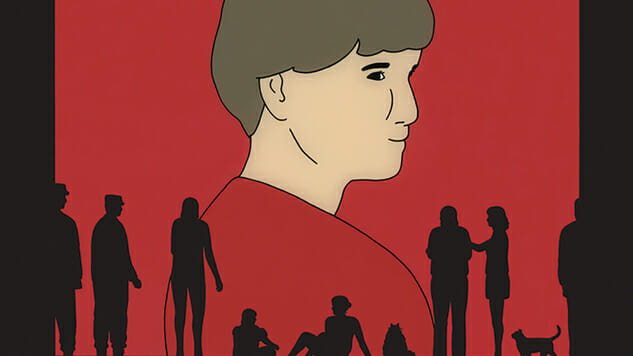Sabrina Cartoonist Nick Drnaso on Paranoia, Conspiracies & Air Force Tattoos
Art by Nick Drnaso
Despite spanning from Chicago to Colorado, the world of Nick Drnaso’s Sabrina is a claustrophobic one. It is there in the rigidity of the panels, the uniformity of Air Force dress, the snow which blankets both settings; it is there in the way time, space and place are bound, abutting, and in the way violence, fear and paranoia are constantly crouching in the corners, the formication-inducing claustrophobia of a tarantula terrarium.
Revolving around the disappearance of its titular character and the impact it has on her sister Sandra, boyfriend Teddy,and Calvin, the friend whose life Teddy augers in to, Sabrina slowly gathers into a meditation on the rampant paranoia and attendant rage in our current climate. Paste caught up with Drnaso for an email interview to dig deeper into Sabrina, out now from publisher Drawn & Quarterly. The following has been lightly edited for clarity.
![]()

Sabrina Cover Art by Nick Drnaso
Paste: I must admit my unfamiliarity with comics as medium beyond superhero books. Something that struck me was how useful the literal architecture of the book was to getting across your story; the rigidity of the panels giving way to the liminal moments when characters and/or scenes shifted time and/or space, little moments of confusion that work themselves out. How did the physical format of the book help you to tell the story?
Nick Drnaso: The page design and the grid I use just provides a framework I need to keep working every day. From my own experience during the actual drawing of the book, that structure allows me to get further involved in the story, and I can only hope that a reader will have a similar experience. I picked up a lot of comics at a convention in Chicago last weekend that completely annihilate this assumption I’ve been working under, but that doesn’t necessarily mean I would, or even could, adopt someone else’s approach.
Paste: Maybe it’s because of my aforementioned comic unfamiliarity, but I sometimes had a hard time picking apart Calvin’s colleagues on the Air Force Base. It reminded me a bit of a Bret Easton Ellis novel, where every character is amorphous and interchangeable in a quasi-sinister way. Was having a bunch of characters in uniform a conscious choice to get that paranoia across?
Drnaso: I decided to set it in Colorado and use my friend’s experience in the Air Force well before I started drawing the book, and I guess I had a hunch that those environments would be an interesting backdrop for this type of story, both conceptually and visually. When I toured around Colorado Springs and Peterson Air Force Base with him in preparation for this book, I recognized things that I’ve always responded to visually: parking lots, austere office buildings, rigid structures, carefully ordered groundskeeping, etc.
I should use this opportunity to point out that there were a few flaws in the story that weren’t pointed out to me until I was too far along to change them: airmen don’t wear their caps indoors, only outdoors and when they are out in the world in uniform. I was at a point where I could have changed that, but I liked the way they looked in caps, partially because, as you noticed, it made those characters look even less distinguishable from each other. Also, my friend pointed out that getting a tattoo of the Air Force insignia is a huge faux pas, which shocked me. I so assumed that would be such a part of the culture that I didn’t even check that detail with him, but he laughed when he saw the book and said getting a tattoo like that is basically a rookie mistake and will earn you the scorn and ridicule of your fellow airmen. Also, it is “airmen,” apparently, no matter the gender. At least I think I got that right.
Paste: Having a military character far from any battlefield seems a good analogue for how Sabrina treats violence; it’s a violent story, without a single panel of bloodshed. Instead, its violence happens either off panel or crescendos but doesn’t come. Did you think this helped to better create tension and keep the focus on the mental state of Calvin, Teddy and Sandra?
Drnaso: Yea, I think I saw a lot of what I considered “potholes” that I tried to avoid, even though those things are hard to define now in retrospect. I’ve come to think of a given decision in a comic as actually a thousand or more “non-decisions,” kind of whittling down a potentially bad idea until maybe you arrive at something usable. So it’s really hard to say what the cause and effect was between all of these decisions and the reading experience of a stranger.

